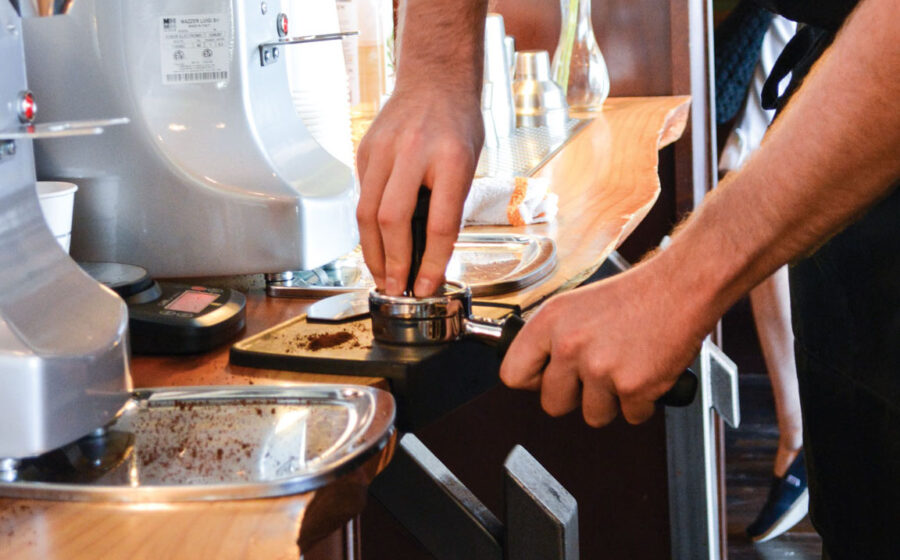[I]magine you’ve stepped into the shower. The water feels all right, but it could be a little hotter, so you reach for the knob and twist. With a precision you don’t possess most any other time, you finesse the dial a fraction of a millimeter toward the red H and the temperature almost imperceptibly changes. Perfect. Not too hot, but more than warm. It is a ritual we all go through on a regular basis, and we don’t compromise until we have a shower that is perfect.
That same commitment to perfection should extend into our cafés as we adjust the grind for our espresso extractions. Last month I explained that several factors affect the quality of a shot of espresso, but few as much as the precision and quality of the grind.
I’ll suppose we’re on the same page and you’re committed to checking the grind every morning before you serve a single espresso. You’ve ground the coffee, dosed it, tamped it, extracted it, made confident adjustments to get it into that twenty- to thirty-second window. It tastes incredible, and you can’t wait to serve it. Finished, right? Not quite.
The Education Series



It isn’t enough to just “set it and forget it.” High-quality espresso grinders are precision machines designed to be consistent and reliable, but even the best of them can’t assess your espresso shots for you and make adjustments on the fly. That responsibility rests exclusively in the hands of a trained barista.
As your business ebbs and flows throughout the day, changes could be happening inside your grinder that you’ll only see in your espresso shots. As the line of customers gets longer, and your café gets busier, your grinder will see heavier use. The metal burrs will grind more coffee more often, and as they do they will heat up. Heat causes metal to expand, and the expansion of your burrs will make the grind finer. Not a lot finer, mind you, but enough to significantly change the extraction of espresso. That finer grind will cause your shots to run more slowly, increasing the extraction and potentially lead to unpleasant, overly bitter flavor characteristics.
A well-trained barista will see the flow and color of the espresso shots change and make a small, intentional adjustment to coarsen the grind. The espresso starts flowing regularly, and your customers never experience an off flavor.
Later, after lunch, as the café slows down and your baristas begin to clean and recover from their busy morning, the grinder’s burrs cool. The temperature reduction causes them to retract from their expansion, which makes the grind coarser. The barista had already adjusted the grind though, and now this further change causes espresso to run more quickly, preventing the coffee from extracting properly. Instead of bitter, over-extracted espresso, you’re now faced with sour, thin shots. Equally unpleasant in their own way.
Your well-trained barista also recognizes this, and rectifies the situation with another small adjustment.
Without that well-trained barista confidently working with the grinder, the whole morning and afternoon looks different. Your line inexplicably starts to slow down—at the worst time!—when the shots are pulling more slowly, and when your customers finally get their drinks, they don’t even taste right.
Beyond the relative busyness of the café, the ambient temperature and relative humidity in the room can affect the grind as well. As the café heats up, the grind changes. If a customer props open the front door on a cool and breezy morning, and chilly air wafts over the grinder, the grind changes.
Like the temperature adjustments in your morning shower, the grind adjustments necessary to combat these environmental changes are minor. Just like that uncomfortably lukewarm shower demands immediate attention, decisive and timely adjustments to the grinder are imperative to giving our customers the best possible flavor experience.
What do those adjustments look like?
As mentioned, they’re small. If you dialed in your espresso in the morning, and you’ve paid attention to it throughout the day, it shouldn’t get so out of control that large recalibrations are necessary. Millimeters to a centimeter or two are in the range you should expect, depending on the make and model of your grinder.
Second, the more often adjustments happen, the smaller they need to be. The only way they happen often, though, is if a great deal of attention is being paid to the espresso. Time every shot, whether your espresso machine includes a timer or not! You’ll pick up on small changes much more quickly if you rely on a good timer instead of instinct. Twenty-four seconds doesn’t feel that much shorter than twenty-six seconds, and over the course of dozens of drinks, losing fractions of a second with every shot can lead to dramatic changes in the espresso’s flavor without each shot being a noticeably different length than the one before it.
Third, every barista who is tasked with making espresso should be comfortable adjusting the grinder. If you trust them to make a latte, trust them to understand grind changes as well. You don’t want to have a line out the door when you need to adjust the grind, only to find out that your “grind adjuster” isn’t working that shift.
It’s been stated before, but it bears repeating: we don’t get many chances to make a good impression with our customers. We’re fortunate if we get more than one. We can’t afford to let trepidation with a piece of equipment prevent us from serving the highest quality products we can. Training all of our staff—baristas, shift supervisors, and managers—in the science of grind adjustment benefits everyone, but most of all, our customers.
—Nathanael May is the director of coffee at Portland Coffee Roasting.
















